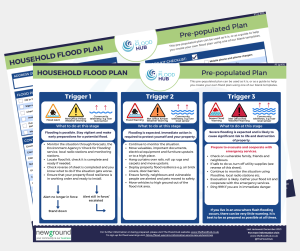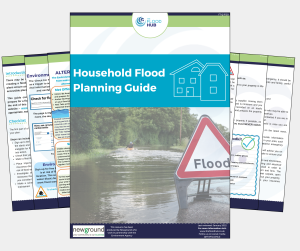This blog has been written by a member of the Newground Flood Team.
Flooding can cause devastating damage to homes, belongings and wellbeing. This blog will we explain why flood planning matters, what key steps you should take to prepare your home, how to create a practical flood plan, and where to find useful resources such as flood warnings and property flood resilience (PFR) measures. Being prepared can significantly reduce the impact of flooding and speed up recovery, protecting both your property and peace of mind.
Household flood planning is essential because it helps you prepare and know exactly what to do if a flood event occurs. Managing flood risk is a shared responsibility, it involves not just organisations and agencies, but everyone living and working within a catchment area. The catchment-based approach to flood management recognises this by viewing the whole water system as a connected puzzle. It combines different actions from multiple stakeholders across the catchment to better manage water flow and reduce flooding impacts.
While various measures are in place to manage flood risk, these interventions are designed and built to offer a certain standard of protection. However, they cannot completely eliminate the risk, we have already seen examples of flood defences being over-topped, such as in Carlisle, Cumbria, on more than one occasion. This highlights why homeowners and businesses should never rely solely on these measures to keep their properties safe.
Because climate change is increasing the frequency and severity of flooding, having a household flood plan and considering property flood resilience (PFR) options is more important than ever. Flood planning helps reduce damage and disruption caused by flooding and makes recovery faster and easier. If you haven’t experienced flooding before, it’s a good idea to understand your flood risk by considering factors like flood sources, how often flooding might occur, and how deep or long-lasting the floodwater could be. You can check your flood risk online by entering your postcode here.
What is household flood planning?
Household flood planning involves preparing in advance for a potential flood event to enable a swift, organised response that reduces damage and speeds up recovery. Many people who have experienced flooding describe how rapidly water can approach and enter their homes, often leaving little time to think clearly. This is why having a flood plan is so important, it formalises a set of clear, actionable steps that you can follow immediately after receiving a flood warning or alert.
Because flood events can develop quickly, prioritising your actions beforehand is essential. Deciding in advance how you will respond to different warning levels helps to avoid panic and ensures you protect your home and loved ones as efficiently as possible.
What should you consider when flood planning?
A key part of your flood plan should be registering for the Environment Agency’s free flood warning service. This service sends alerts and warnings via phone, text, or email to multiple household members, keeping everyone informed. You can check if you are eligible and sign up by calling the Floodline number on 0345 988 1188 or by registering your details online by clicking here. Understanding the differences between flood alerts and warnings will help you know exactly when to activate your plan. Download our flood warnings guide by clicking here.
While not all areas are covered by these alerts, there are other useful triggers to keep an eye on, such as Met Office weather warnings, updates from local news and radio, social media alerts, and monitoring services for nearby rivers and seas. Download our alternative flood warning resource here.
What Should You Include in Your Household Flood Plan?
Creating a household flood plan doesn’t have to be complicated. In fact, a simple, well-organised plan can make all the difference when it comes to protecting your home and family during a flood. Here’s what your flood plan should ideally include to help reduce flood damage, keep everyone safe, and speed up recovery:
Step-by-step actions:
List clear, practical actions to take when a flood warning is issued. Simple measures like stacking furniture on elevated surfaces can save your most valuable and expensive belongings. For example, placing two pairs of wellington boots under each leg of a dining table or using upturned buckets under sofas and chairs can raise them above floodwater levels, protecting them from damage.
Essential contact details:
Keep an updated list of important contacts such as emergency services, your insurance provider, local authorities, flood response agencies, and trusted friends or family members. After a flood, tradespeople like electricians and drying specialists will be in high demand, having their contact info handy can help you act quickly and reduce downtime.
Pre-arranged alternative accommodation:
If you need to evacuate, having a safe place to stay is vital to reduce stress, especially for families. Include details of nearby evacuation centres, friends or relatives who can offer shelter, or local hotels and B&Bs. Remember, during widespread flooding, accommodation options can fill up fast, so it’s good to plan ahead. Most home insurance policies cover the cost of temporary housing.
Location and instructions for flood protection products:
If you’ve invested in property flood resilience (PFR) products, such as flood barriers or air brick covers, make sure your plan includes where these are stored and how to install them quickly. These measures can significantly reduce floodwater entry and damage. If you haven’t yet considered PFR, it’s worth looking into; you can even install protective measures gradually to spread the cost.
Utility meter locations and shut-off procedures:
Knowing how and where to turn off your electricity, gas, and water supplies is crucial to avoid further hazards during a flood. Include detailed instructions so that you, or someone you trust, can safely disconnect utilities to prevent damage or accidents.
Your emergency flood kit:
Prepare a flood grab bag or suitcase stocked with essentials you’ll need if you have to leave your home quickly. This should include medicines, phone chargers, spare clothes, toiletries, important insurance documents, torches, wellington boots, cash and cards. Adding a camera, a notepad and pen, and a waterproof marker can help you document flood damage for insurance claims.
Post-flood recovery information:
Flood recovery can be overwhelming, so having a checklist of what to do next is invaluable. Include contact details for insurance companies, professional drying and cleaning services, and advice on safe re-entry and property restoration. Knowing what questions to ask your insurer can help ensure a smoother claims process.
To help you get started, you can download a household flood plan template by clicking here.

Keep it simple and clear:
Your flood plan should be easy to understand and quick to follow—ideally just a couple of pages or a double-sided sheet. Clear instructions and contact details also allow a trusted friend, neighbour, or family member to act on your behalf if you’re not home when a flood happens.
For further information you can download a home flood planning guidance booklet by clicking here.
